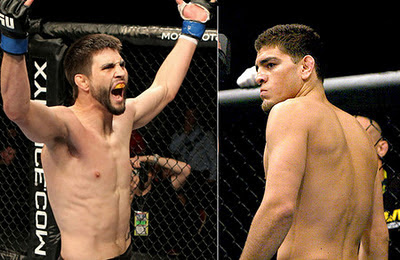 By Jacob Kindt
By Jacob Kindt ![]()
![]()
![]()
In the media runup to this most recent UFC event in Toronto, Dana White has mentioned “requesting” monitors for the judges. This seems like a straightforward solution to some of the problems with judging, however there are a number of issues regarding how the monitors could be used, as well as how monitors and cameras are currently being used. Employing monitors has advantages and disadvantages, and some specific uses will positively affect the judging in MMA. However, it is important to take into account all scenarios, and note how troublesome monitors and cameras could be in other situations.
Penalty Reviews: Penalty reviews are already in use in the UFC, specifically in Las Vegas. In this situation the referee can review an illegal blow to determine how to penalise the offender. This sport is unique in the way that one small bad call can swing a win, or bring about a loss. In such a competitive sport as MMA one loss can make the difference between headlining and being cut from a promotion’s roster. To bring up a specific example of the foul review, Jon Jones vs. Matt Hamill featured a tape review to see if illegal strikes landed and contributed to Hamill not being able to continue the fight. This was important because this happened in the first round, which resulted in a disqualification of the offender. Had it happened in the second or third round, the referee would have deducted the penalty point(s), and the fight would have gone to the score cards.
A second example, one where foul review would have been useful, was in the Josh Koscheck vs. Paul Daley fight, where Daley was called for an illegal knee. This replay would have been particularly effective, as Daley threw 2 knees — the first landed, the second missed — and with no foul review Koscheck was rushed in his recovery time. This could have potentially altered the outcome of the fight.
Obscured Vision: Judges are positioned nearly equally around the cage, so that there are no blind corners; with 3 judges, octagonal and round MMA cages are the most effective. Different shapes can be slightly more troublesome; Bellator at one point was using an uneven hexagon that could have left some blind corners. Many fighters with strong wrestling decide where the fight will take place, and most pick the corner with their coaches. Yet because of how the fighters and judges are configured, judges are likely to see top position as a definitive advantage, especially when the rest of the fight is obscured. This would be a brilliant use of cameras and monitors, particularly the camera angles from the opposite sides of the cage from each judge. My personal conversations with judges have uncovered a sort of tunnel vision where the monitors are concerned; they consider it their job to judge what they can see, not necessarily what is happening on the opposite side.
Round Review: There is precisely one minute between rounds. Are these monitors there to perhaps give judges a self-paced review of the round, allowing them to get a second look at some exchanges? I can see how this would be useful, as many fighters lose a whole round, only to rally in the last few seconds and “steal” the round with the judges, who tend to score the most recent as the most important. If you recall Matt Serra vs. Matt Hughes, Serra dropped Hughes in the first round, though with a closer look, the knockdown turned out to be the result of an unintentional head butt missed by the referee. This is a good example of where the round review would have been useful, as to not weigh that exchange too heavily when judging who won the round.
Effective Judging: Will making camera angles and monitors available for judges make them better, more reliable and more effective at scoring rounds properly? I do not believe so. Education and accountability is what will make judging more effective. There is a quote “Leg kicks do not end fights” that came out of a mouth of a judge. This is not only completely false (See Patrick “HD” Barry), but it makes a mockery of MMA in general. The criteria for scoring striking is “effective striking.” Saying a leg kick is not effective by virtue of not having the ability to give a concussion is easily comparable to calling a submission like a keylock or heel hook not worth scoring, as they too are unlikely to end fights. No amount of cameras and monitors will change a bad judge into a good judge. There is no angle or additional view that can change an ignorant, ineffective judge into a good judge.
Monitors for the judges will not solve the sport’s judging issues, though it will affect accountability. It will remove one small phrase that judges use to justify poor scoring: “I can only judge what I see.” It could help with the process of removing judges from the MMA pool, and make room for people who understand the sport with greater detail and less bias. Right now there is an option for fighters to deny specific referees from reffing their fights. You will never see Brock Lesnar in another fight with Steve Mazzagatti as the referee. If this was a similar option for fighters and promoters unhappy with judges we would likely see an improvement in the quality of judges. Monitors could make this even more of a possibility, as their presence can create slightly more accountability on the part of the judges if fights are not scored appropriately, but the amount is strongly dependent on the way these monitors are used. Is their addition a complete solution? I do not believe so, but it may be a step towards improving the quality of judges.


